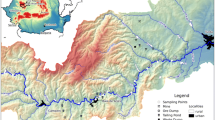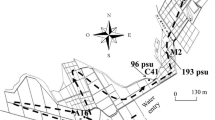Abstract
During 17 successive years (1969–1985) the macrozoobenthos has been sampled quantitatively in the latewinter/early-spring period at 15 stations scattered over Balgzand (a 50 km2 tidal flat area in the western-most part of the Wadden Sea) and at 5 stations located in a small (3 km2) area 150 km away from Balgzand in the eastern part of the Dutch Wadden Sea. In 25 species, numbers per m2 were, in most years, sufficiently high at 2 or more of the Balgzand stations to allow between-station comparisons of fluctuation patterns. Comparisons were made by rank correlation. Out of a total of 1003 of such comparisons that could be made with the Balgzand data, 47% yielded significantly positive correlations and less than 1% significantly negative ones. Thus, nearly half of the fluctuation patterns of the populations living at the 15 stations within the Balgzand area showed a high similarity. Synchronization of population fluctuations was augmented particularly by the incidence of severe winters (causing low spring numbers in about a quarter of the species that were sensitive to low temperatures and high reproductive success in several species during the subsequent summer) and further by the increasing trends in numbers in about half of the species, probably as a consequence of eutrophication.
Similar results as on Balgzand were obtained within the restricted area Groninger Wad in the eastern part of the Dutch Wadden Sea (Essink & Beukema, this issue). Comparison of the fluctuation patterns between the 2 distant areas also yielded high numbers of significantly positive correlations, though the proportion of the patterns that were similar was lower than these proportions were within the 2 areas.
It is concluded that common patterns of fluctuation in numerical densities of macrobenthic species can be assessed over vast areas. Such common patterns will represent the ‘normal’ or ‘base-line’ fluctuations that may be used to distinguish (as departures from such patterns) the effects of local disturbing influences.
Similar content being viewed by others
References
Andersin, A.-B., J. Lassig, L. Parkkonen & H. Sandler, 1978. The decline of macrofauna in the deeper parts of the Baltic proper and the Gulf of Finland. Kieler Meeresforsch. 4: 23–52.
Beukema, J. J., 1973. Migration and secondary spatfall of Macoma balthica (L.) in the western part of the Wadden Sea. Neth. J. Zool. 23: 356–357.
Beukema, J. J., 1974. Seasonal changes in the biomass of the macrobenthos of a tidal flat in the Dutch Wadden Sea. Neth. J. Sea Res. 8: 94–107.
Beukema, J. J., 1979. Biomass and species richness of the macrobenthic animals living on a tidal flat area in the Dutch Wadden Sea: effects of a severe winter. Neth. J. Sea Res. 13: 203–223.
Beukema, J. J., 1982. Annual variation in reproductive success and biomass of the major macrozoobenthic species living in a tidal flat area of the Wadden Sea. Neth. J. Sea Res. 16: 37–45.
Beukema, J. J., 1984. Zoobenthos survival during severe winters at high and low tidal flats in the Dutch Wadden Sea. In J. S. Gray & M. E. Christiansen (eds), Marine biology of polar regions and effects of stress on marine organisms. John Wiley, Chichester: 351–361.
Beukema, J. J., 1985. Growth and dynamics in populations of Echinocardium cordatum living in the North Sea off the Dutch north coast. Neth. J. Sea Res. 19: 129–134.
Beukema, J. J. & G. C. Cadée, 1986. Zoobenthos responses to eutrophication of the Dutch Wadden Sea. Ophelia 26: in press.
Beukema, J. J. & J. de Vlas, 1979. Population parameters of the lugworm, Arenicola marina, living on tidal flats in the Dutch Wadden Sea. Neth. J. Sea Res. 13: 331–353.
Beukema, J. J., G. C. Cadée & H. Hummel, 1983. Differential variability in time and space of numbers in suspension and deposit feeding benthic species in a tidal flat area. Oceanol. Acta Vol. Sp.: 21–26.
Beukema, J. J., W. de Bruin & J. J. M. Jansen, 1978. Biomass and species richness of the macrobenthic animals living on the tidal flats of the Dutch Wadden Sea: Long-term changes during a period with mild winters. Neth. J. Sea Res. 12: 58–77.
Colebrook, J. M., 1978. Continuous plankton records: zooplankton and environment, North-East Atlantic and North Sea: 1948–1975. Oceanol. Acta 1: 9–23.
Colebrook, J. M., 1987. Environmental influences on long-term variability in marine plankton. Hydrobiologia 142: 309–325.
Cushing, D. H., 1982. Climate and fisheries. Academic Press, London, 373 pp.
Dekker, R., 1979. Numbers, growth, biomass and production of organic and calcareous matter of Hydrobia ulvae (Gastropoda: Prosobranchia) in the western Dutch Wadden Sea. Interne Verslagen, Ned. Inst. Onderz. Zee, Texel, 1979–15, 27 pp.
De Vlas, J., 1973. Migratie via getijstromen van jonge nonnetjes, Macoma balthica L., op en rond het Balgzand. Interne Verslagen, Ned. Inst. Onderz. Zee, Texel, 1973–14, 30 pp.
Essink, K., 1978. The effects of pollution by organic waste on macrofauna in the eastern Dutch Wadden Sea. Publication Series, Neth. Inst. Sea Res., Texel 1: 1–135.
Essink, K. & J. J. Beukema, 1987. Long-term changes in tidal flat macrozoobenthos as an indicator of stress by organic pollution. Hydrobiologia 142: 209–215.
Farke, H., P. A. W. J. de Wilde & E. M. Berghuis, 1979. Distribution of juvenile and adult Arenicola marina on a tidal mud flat and the importance of nearshore areas for recruitment. Neth. J. Sea Res. 13: 354–361.
Gray, J. S. & H. Christie, 1983. Predicting long-term changes in marine benthic communities. Mar. Ecol. Prog. Ser. 13: 87–94.
Jensen, K., 1987. Long-term changes of the macrozoobenthos in the Baltic Sea and the Kattegat area. Hydrobiologia 142: 129–135.
Kendall, M. A., R. S. Bowman, P. Williamson & J. R. Lewis, 1985. Annual variation in the recruitment of Semibalanus balanoides on the north Yorkshire coast 1969–1981. J. mar. biol. Ass. U.K. 65: 1009–1030.
Lewis, J. R., 1987. Latitudinal patterns and problems in the rocky littoral. Hydrobiologia 142: 1–13.
Lundälv, T. & H. Christie, 1987. Comparative trends and ecological patterns of rocky subtidal communities in the Swedish and Norwegian Skagerrak area. Hydrobiologia 142: 71–80.
Svane, I., 1984. Observations on the long-term population dynamics of the perennial ascidian, Ascidia mentula O. F. Müller, on the Swedish west coast. Biol. Bull. 167: 630–646.
Van der Hoeven, P. C. T., 1982. Observations on surface water temperature and salinity, State Office of Fishery Research (RIVO): 1860–1981. Scientific Report W.R. 82–2, KNMI, De Bilt: 118 pp.
Author information
Authors and Affiliations
Rights and permissions
About this article
Cite this article
Beukema, J.J., Essink, K. Common patterns in the fluctuations of macrozoobenthic species living at different places on tidal flats in the Wadden Sea. Hydrobiologia 142, 199–207 (1986). https://doi.org/10.1007/BF00026759
Published:
Issue Date:
DOI: https://doi.org/10.1007/BF00026759




